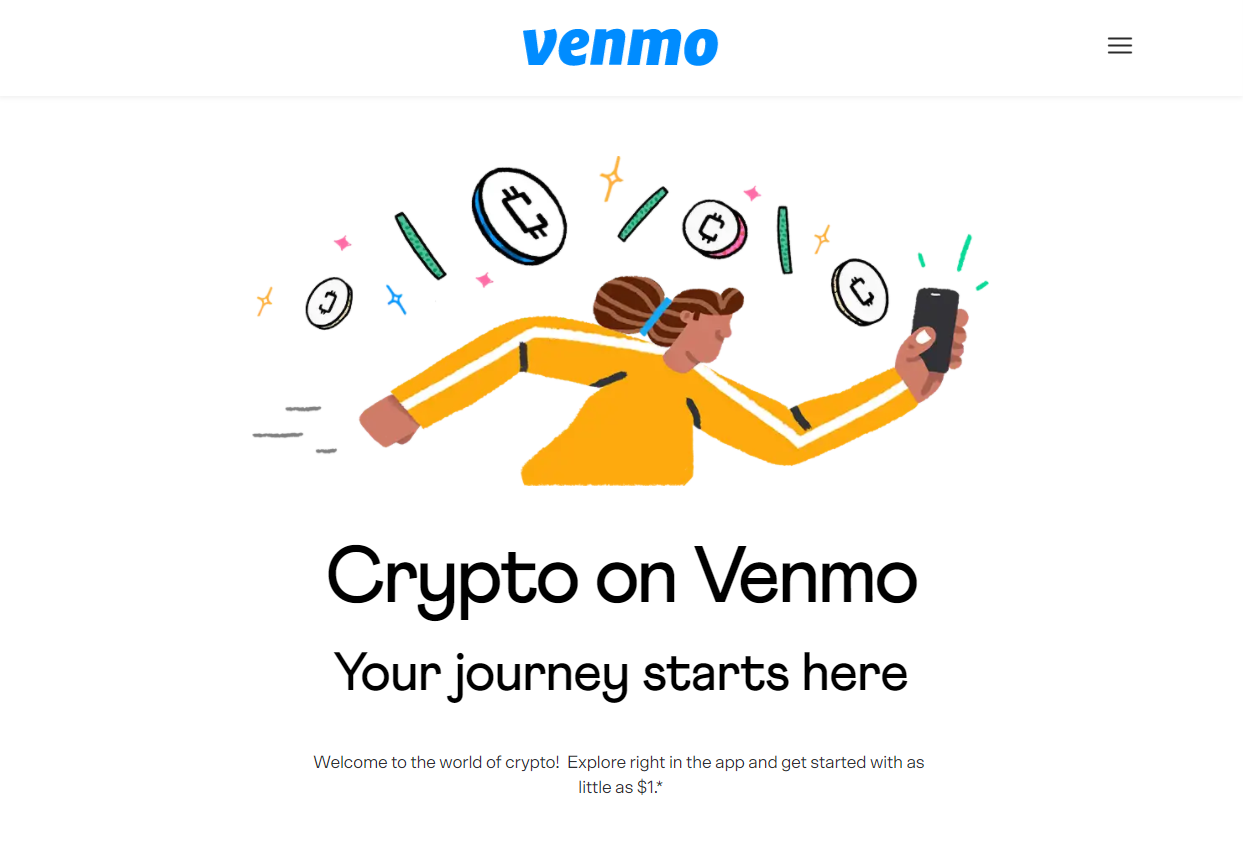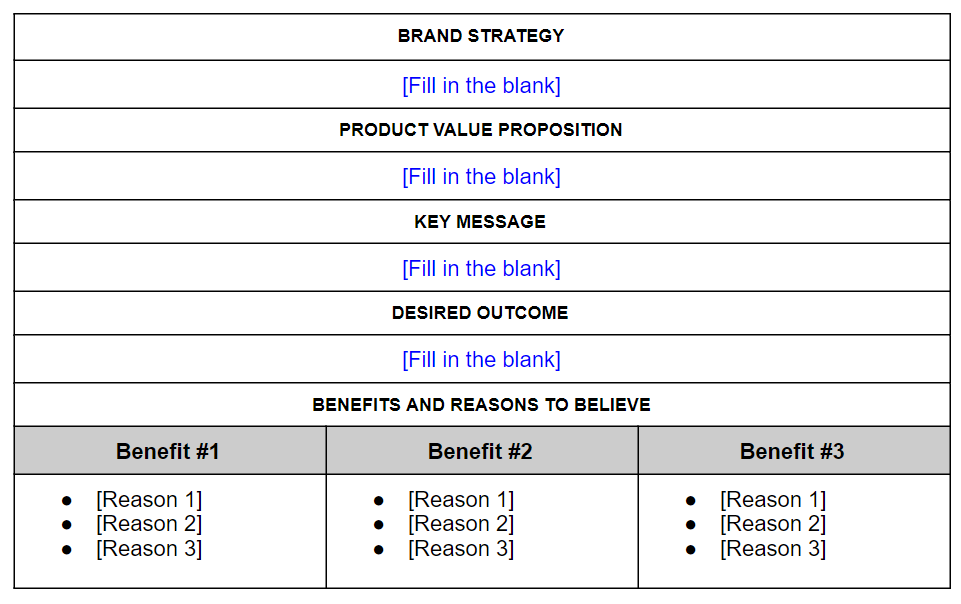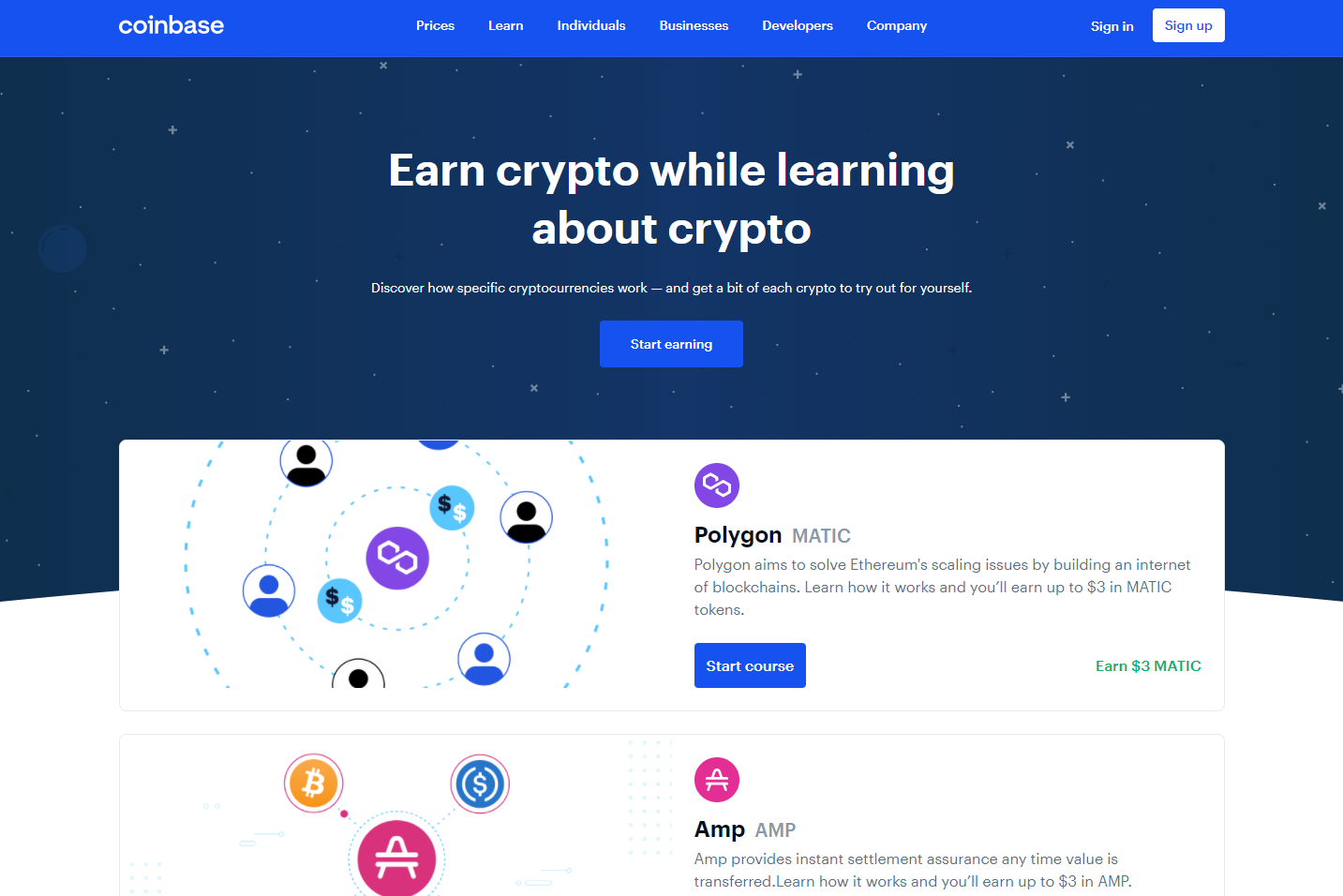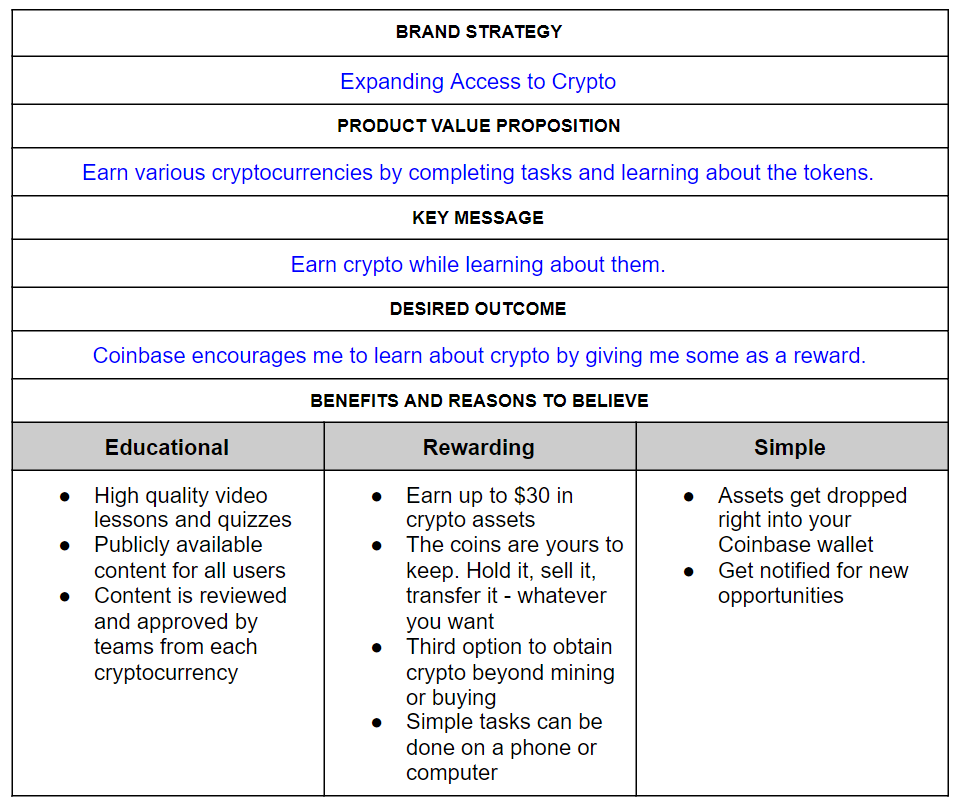Product Marketing Messaging Framework
Contents
What is a Messaging Framework?
The goal of the messaging framework is to clearly lay out the main message of campaign and why it is believable to the audience. In other words - what are you trying to tell the customer and why should they trust you? The messaging framework is most fundamental part of the Product Marketing brief and if done correctly, it will allow the rest of the elements of the brief to come together.
We use the messaging framework to clearly articulate our thoughts so that it can be easily digested by the rest of the team internally. Don’t worry about coming up with catchy headlines or having the perfect copy — that’s what the Creative team is for!
The Product Marketer’s job is to communicate to the user what the new product is and why it is beneficial to them. Before jumping into what the campaign should say, it’s good to first get clarity on what the business would like to achieve with this product. Skip the nitty gritty details of metrics, OKRs, and data for now. At a very high level, what is the business goal? For that, I like to use the “Get Framework”.
The Get Framework
A quick way to figure out the strategy of the launch is by using the “Get Framework” (Get → Who → To → By).
For example, if you’re working on Venmo’s new crypto launch, a potential Get Framework could look like this:
Get crypto-curious Venmo users
Who find other crypto purchase methods too daunting
To purchase their first crypto with Venmo
By making it easy to purchase in-app with low investment requirements
 This is what Venmo launched in April 2021
This is what Venmo launched in April 2021
Get establishes your target user. Who describes a major pain point of theirs. To illustrates the action you want them to take. By explains why they would take action.
Once you have the strategy, it becomes more clear who you’re building for and what makes the product special. Now you can move onto the messaging framework to figure out what you want to say to your customer.
Messaging Framework
These are the elements of the messaging framework:

Brand Strategy
First, start off with a very high level question. Will this campaign further one of your company’s top-line brand strategies? If your company doesn’t have these laid out, I would think about what the company would like their customer say to about their brand.
Brands can’t stand for everything at once - they have to choose just a few if they really want to own that space. For example, McDonalds wants to be known as the consistent and fast burger chain. They can’t also own customizable (Burger King - Have It Your Way) and freshest (Wendy’s - Never Frozen) in customers’ eyes.
Which of your company’s brand identity pillars will your campaign continue to hammer home into the customer’s mind? Answering this question early on will ensure that your product is aligned with the overall company goals.
Product Value Proposition
This should describe the part of the product that differentiates it from your competitors. Why would a user choose this instead of the other product? What would compel a user to switch to yours?
A common mistake is just writing what your product does. This isn’t good enough in a competitive space because if your features match those of your competitors, then it gives little reason for people to try yours. A PMM should be able to highlight the features that will help it stand out early on in the product planning phase or work with the Product team to add it to the roadmap. If you’re able to do that, you’ll save yourself the headache of having to market a product that customers won’t respond to.
There will be times when the product isn’t exciting or just needs to come to parity with a competitor’s features. If that’s the case, I would think about whether it needs marketing support at all. Maybe it’s best for the user to discover the feature by themselves. If it’s big enough of a product that it still warrants a campaign, then I would figure out what the most valuable part of the feature is for your customer and use that as the value proposition.
Key Message
This should be the one thing that you want your target customer to know.
It needs to be short and sweet - don’t jam a bunch of features and adjectives in there. The key message must be very basic so that whoever sees your message can digest it quickly and (hopefully) remember the one thing critical word or phrase.
You might be thinking, “But this is a huge launch and there are so many things we want people to know. I need 2-3 Key Messages.” I disagree. This may be a huge launch for your team that will change the trajectory of your company, but from the perspective of a customer, it’ll be tiny spec in their day to day life (sorry). That means that most customers will give you 5 seconds of their day if you’re lucky. Make it count by giving them just one key message to think about.
And yes, your most loyal users will want to know more. That’s what the Benefits and Reasons to Believe sections are for.
Desired Outcome
This is what you want your target customer to think or feel after seeing your campaign, written from their perspective. Think of it as almost the reverse of the Key Message. By clarifying the desired outcome, you can crystalize how you want the user to be impacted after seeing your work. The desired outcome of campaigns aren’t always to just understand what the feature is. The desired outcome could be shifting perception, generating excitement, or even feeling heard as a customer.
Benefits
These are the pillars of what makes your product awesome and differentiated. Ideally you can capture the theme in one or two words per benefit. Benefits can be anything that helps the customer in some way. Lower cost, better safety, more efficient, improved confidence, more seamless, etc.
Imagine you’ve caught a user’s attention with your Key Message - now what? Give them the general bullet points on how this product will help them in their life. Remember, these should be benefits from a user’s perspective!
In a larger product launch, bundle features together into themes so that the benefits are easily digestible. The detailed bullets should live in the Reasons to Believe.
Reasons to Believe
Why should a customer “believe” in the benefits your listed? This is your chance to give all the details about why your product is awesome. If a user asks, “You claim this product will make my online identity safer - how so?” You should be able to go to the “Safety” Benefit in your framework and read off all of the Reasons to Believe underneath.
I would error on the side of being exhaustive with this list. Once you start developing your campaign, the entire marketing / PR team tends to refer to these bullets as the source of truth for the product features. Because you’ve done all the legwork upfront, the copywriter who is putting together the email, or the designer who is creating the website, or the publicist replying to reporters can easily pull what they need.
Let’s Do An Example
I’ve found that I learn best through examples, so I created this example messaging framework for a real product that was launched.
Sticking with the crypto theme, Coinbase launched their educational product called Coinbase Earn in December 2018. I thought this was so cool when it launched and I’m glad they’ve kept building on it in the past few years.
 Coinbase Earn landing page. You can also watch their launch video here.
Coinbase Earn landing page. You can also watch their launch video here.
One of the biggest problems holding crypto back from mainstream adoption is that it’s hard to understand what each coin does and what is different about them. Coinbase Earn teaches users about different coins and rewards them with some tokens from the coin they just learned about. It’s a great way of increasing overall understanding of the space and increasing adoption.
Let’s pretend like we’re the PMM on this product. What would our messaging framework look like?
Disclaimer: I do not work for Coinbase or have any insight into how they operate as a Product Marketing team. They may use a different messaging framework altogether. This is just an illustrative example.
Brand Strategy
Coinbase’s mission is to “increase economic freedom in the world” and one of the pillars of that is to “make blockchain technology more accessible”. I interpret that as making it easier for people to buy / sell / store crypto, but also helping bring crypto to the mainstream by educating people.
Thus, the brand strategy we’re going with in this example is “Expanding Access to Crypto”.
Product Value Proposition
There are numerous websites online where you can learn about different crypto. Every token has its own white paper as well if you want to read the technical details (bitcoin.pdf). What makes Coinbase Earn special is that it’s the only place where you can earn real tokens while you’re learning about them in the educational modules. That’s the hook that differentiates this product and that’s why it should be the Product Value Proposition.
The Product Value Proposition isn’t meant to be consumer facing, so it’s OK if it includes some jargon that you may not want to surface to the customer. You’ll remove those details for the Key Message to make it very simple.
Key Message
“Earn crypto while learning about them.” The blog headline made this easy for us and I’ve simplified it further. As we mentioned in the Product Value Proposition, it’s the combination of earning and learning that makes this special. That is what we want the user to remember.
Desired Outcome
Ideally, the product also helps solidify the brand identity for the user. I initially wrote “Coinbase gives me tokens for learning about crypto”, but changed “gives” to the word “encourage”. I think “encourage” speaks more to Coinbase’s goal of increasing access for everyone. Police can “give” traffic tickets, but they can also “encourage” safer driving. There’s a slight shift in intention there.
“Coinbase encourages me to learn about crypto by giving me tokens as a reward.”
Benefits
As I mentioned before, Learn and Earn are the biggest benefits that the user will receive from participating in this program. They also benefit from the wallet functionality of Coinbase. Without this last piece, they’d have to figure out how to set up their own 3rd party wallet and transfer their earnings to it. Coinbase makes it easy by allowing them to just store everything in their pre-made wallet.
The way I like to name these benefits is by filling in the blank for “This product is [benefit]”. I’ve grouped them into these three buckets:
- Educational
- Rewarding
- Simple
Reasons to Believe
RTBs are for meant to show the details of every benefit. A good way of writing these support bullets is by answering “How is it [benefit #1]?”.
How is it educational?
- High quality video lessons and quizzes
- Publicly available content for all users
- Content is reviewed and approved by teams from each cryptocurrency
How is it rewarding?
- Earn up to $30 in crypto assets
- The coins are yours to keep. Hold it, sell it, transfer it - whatever you want.
- Third option to obtain crypto beyond mining or buying
- Simple tasks can be done on a phone or computer
How is it simple?
- Assets get dropped right into your Coinbase wallet
- Get notified for new opportunities
The final messaging framework would look like this:

One of the criticisms of this messaging framework is that many of the elements are similar to each other. I think there are nuances to them and they’re important to recognize, especially for the Creative team when producing the materials. However, if the project is small, you can get rid of the Brand Strategy and Desired Outcome sections and still be OK. The shift from Value Proposition to Key Message is still critical because it forces you to dumb down your message significantly.
I hope that example helped crystallize some of the concepts in the messaging framework. As I mentioned in the beginning, getting this part right helps bring all the other pieces of a Product Marketing Brief together. Make sure to not rush this part - it’ll be painful to adjust later in the process.